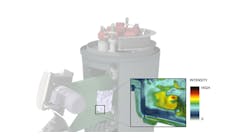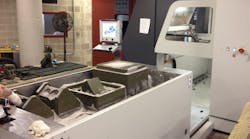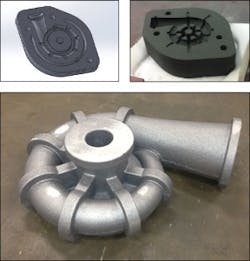For complex organizations like metalcasters, the need for information expands continuously, and so then does the need for technology platforms that collect data, coordinate and analyze it, and communicate it with convenience and reliability. That’s the case for enterprise resource planning software.
Over the past decade, there has emerged several ERP programs specifically focused on metalcasting, which is more proof of that need, but proof also of the importance of managing that enterprise data with a greater focus on specific types of information, specific to metalcasting processes and industrial standards.
A more recent development is cloud-based ERP, acknowledging the organizational changes in manufacturing enterprises — leaner, less likely to have in-house IT expertise, and in that way having a more acute need for detailed, actionable information on processes and activity.
The next change in ERP is underway now, and it’s a reversal of sorts. Enterprises don’t need simply to control their critical data; they also need to convey specific information to their supply chain suppliers and customers, and to collect essential information from those enterprises. Forrester Research Inc., which specializes in ERP trends, recently noted “customers and employees now expect that information, services, and social media will be available to them, in context, on any device, at their time of need. And, business leaders are taking note: Today, 77% of business decision-makers believe that creating a comprehensive mobile and tablet strategy for customers and partners is a moderate, high, or critical priority for their company.”
Forrester’s observation about devices glides over the more salient point: enterprises need to manage their own information in order to maximize their opportunities with their customers and suppliers.
Interoperability is one of the emphases for the latest release of Epicor ERP, one of the programs that highlight its performance for manufacturing industries. “Epicor ERP version 10 represents the evolution of our innovative technology platform to support today’s business imperatives — social collaboration, deployment flexibility, broad device accessibility, with ease of use and accelerated performance,” Malcolm Fox, Epicor Software vice president explained recently.
Metalcasters take note: your ERP matters to your supply-chain partners. One of the early adopters of Epicor ERP v.10 is Humtown Products Inc., which is not a metalcaster — and that reconfirms the point about interoperability, because Humtown Products’ ERP success benefits its metalcasting customers as well as its own enterprise.
Filling a Wider Niche
At one time, Humtown Products would have been referred to as a patternmaker, but the role that such companies performed has changed considerably. It still designs and produces patterns, but now Humtown fills a wider niche in the metalcasting market, with more capabilities that are needed by foundry customers, whose own range of needs and capabilities are changing.
Humtown is a project development partner to metalcasters. It takes on efforts from initial casting design to tooling production, and then to producing molds and cores that are ready for pouring at foundry operations. Lately, Humtown has incorporated additive manufacturing to its production process to help casting producers convert CAD programs into three-dimensional products, with lead times that are shorter than the standard route from design to pattern, to casting.
Notwithstanding its changing profile, Humtown and its foundry customers continue to hold positions in the supply chain that delivers complex parts industrial sectors that include automotive, rail, industrial, agriculture, and defense, among others.
Humtown has vertical and horizontal sand coremaking capabilities, for cores weighing up to 600 lb. It also has an air-set core machine, and it can complete core washes thanks to electric drying ovens. It also handles core assembly and CNC machining.
Understandably, in the course of its development Humtown’s production capabilities have grown more complex. It holds a patent on the UNItube blow-tube system for cold box coremaking, for example. It has installed a Stratasys Fortus 360 mc production-quality 3D printer to produce prototypes, and is a partner in a National Additive Manufacturing Innovation Institute effort that involves 3D sand printing using an ExOne S Max printer. Even more, through its foundry partnerships it can manage a project from design through prototype cast part, meaning customers can accelerate their time to market for new products.
Coming soon will be laser-scanning process capability, which will equip Humtown to reverse engineer existing product designs, provide dimensional analysis, and perform in-process inspection.
Data Deployment
All these variations require an organization to coordinate and deploy its process data more effectively, and to deliver that information reliably for its own use and for the assurance of its customers. That was the hook for Humtown to adopt Epicor ERP.
“We were running an in-house application, written in PARADOX,” recalled Brenda Mohr, a Humtown Products’ programmer. “Newer Windows platforms were not supporting DOS, as in the past, and so we knew the systems would start to fail. We needed a newer application, but did not want to completely re-write our software — and we did want to maintain the ability to be very customized. Epicor’s software gave us the most opportunity to customize.”
Whereas the Epicor ERP is available as a cloud-based, Software-as-a-Service program, Humtown operates the more standard platform, hosted on its own network. “We’ve chosen our own network because of speed, and less vulnerability (to potential data loss),” Mohr said.
Among the ERP functions that are most critical to the Humtown Products enterprise, a programmer there listed several that have obvious parallel importance to the company and its customers (and potential customers), including sales, orders, invoicing, shipping, and quoting. “The ability to customize the software allows us to run our business, our way. It allows us to serve our customers in a more personalized manner,” according to Brenda Mohr.
Implementing Epicor ERP, and expanding its applications, has been gradual process for Humtown. The original implementation was done in a series of steps, beginning about three years ago. First came the set-up of standard accounts and establishing defaults for handling finances, a step described as “very intricate” by Mohr.
Next came “data transfer,” first of individual jobs, which had to be completed in stages because all of the production machinery at work for Humtown Products is interconnected through the ERP software.
Once in place, the ERP operates as a data exchange point for multiple activities that are critical to Humtown’s performance in a complex supply chain: it makes recommendations on raw material selection; gives activity updates on shipping data; and delivers detailed costing reports. The actual CRM function is still to be implemented, she noted.
How have the Humtown Products’ original ERP objectives been addressed by Epicor ERP? “We have been live for about three years,” Brenda Mohr reported. “We have several customized solutions in place, and the plant floor and Epicor ERP are intertwined.
Although she noted that the operation continues to customize new ideas for its ERP program, there are already notable positive impacts on customer service, including “auto docs” reporting to and from delivery services, and incentive/quoting notifications for Humtown customers.










